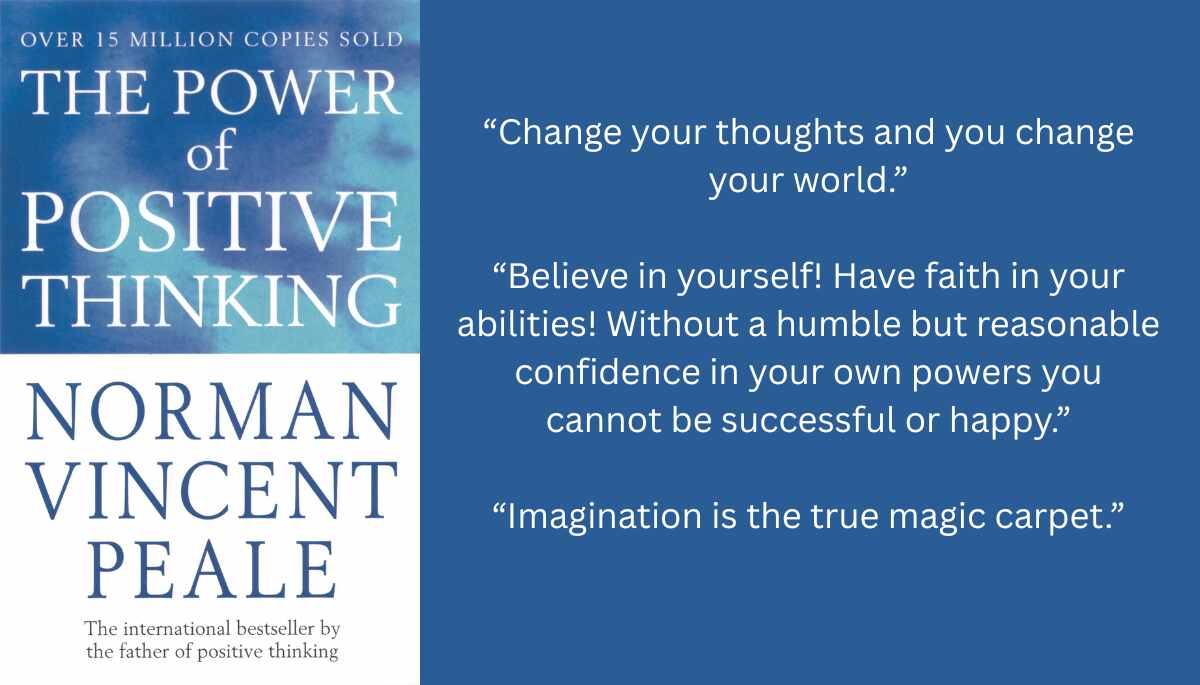Introduction: The Impact of Positive Thinking on Modern Life
In today’s fast-paced, highly demanding world, where stress and anxiety are becoming part of everyday life, a simple shift in mindset can work wonders. This is exactly what Dr. Norman Vincent Peale advocates in his international bestseller The Power of Positive Thinking. First published in 1952, this timeless self-help guide continues to inspire readers by teaching them how to replace negative thoughts with a powerful, positive mental attitude. This book isn’t just about motivational phrases; it’s a practical guide to transforming your life through belief, confidence, calmness, prayer, and action.
This comprehensive review and summary will help you understand what makes The Power of Positive Thinking a must-read for anyone seeking personal, spiritual, emotional, and professional growth.
What Is The Power of Positive Thinking About?
Norman Vincent Peale’s core message is straightforward but profound: Believe in yourself and your abilities, stay positive in your thoughts, and success will follow. The book is built on the foundation that our minds and thoughts shape our reality. If you can train your mind to think positively, you will experience positive outcomes in every area of your life—relationships, career, finances, and health.
Peale combines modern psychology with faith and spiritual guidance, making this book not only psychologically sound but also spiritually uplifting. Through real-life examples, practical exercises, and simple affirmations, Peale shows readers how to create a resilient mindset that can withstand life’s challenges.
Chapter-Wise Summary: Lessons from The Power of Positive Thinking

1. Believe in Yourself
The first step to a positive life is cultivating self-confidence. Peale emphasizes that low self-esteem is one of the biggest roadblocks to success. He explains that by trusting in your abilities and understanding your worth, you can start accomplishing great things. Peale offers practical tips like repeating affirmations, praying, and spending time with encouraging people to build self-belief.
2. A Peaceful Mind Leads to a Powerful Life
Stress and overthinking drain your energy and lead to negative thinking. Peale teaches readers how to clear mental clutter and achieve peace of mind through prayer, relaxation techniques, and faith. A calm mind is essential for smart decision-making and for maintaining emotional balance.
3. Replacing Negative Thoughts with Positive Ones
Peale describes negative thoughts as weeds that must be uprooted regularly. He advises readers to consciously replace every negative thought with a positive affirmation. This habit reconditions your subconscious and alters your reaction to life’s situations.
4. The Power of Faith
One of the strongest themes in the book is the role of faith in developing a positive mindset. Whether it’s faith in God, yourself, or the universe, Peale argues that this faith is what gives people strength in their darkest times. Prayer is recommended not only as a spiritual act but as a mental exercise that aligns your thoughts with positivity.
5. Solving Problems with a Positive Attitude
Problems are a part of life, but how you approach them makes all the difference. Peale suggests that you should trust that every problem has a solution. Instead of panic, he encourages deep thinking, silence, and prayer as tools to find solutions.
6. Creating Consistent Energy Through Mental Conditioning
Your mind and body are interconnected. If you tell yourself you’re tired or incapable, your body will follow. Peale urges readers to use mental conditioning to boost energy levels. Positive self-talk, visualizing success, and staying spiritually aligned help in gaining consistent mental and physical energy.
7. Expecting the Best to Achieve the Best
Expectation shapes reality. If you expect failure, you’ll likely face it. But if you anticipate success, you’re mentally preparing to receive it. Peale uses real-life stories to highlight how people changed their lives by simply changing their expectations.
Core Principles Highlighted in the Book
| Principle | Explanation |
|---|---|
| Believe in Yourself | Self-trust leads to confidence and success |
| Think Positively | Replace negative thoughts with affirmations |
| Maintain Inner Peace | A calm mind is a strong and productive mind |
| Use Prayer as a Tool | Builds spiritual and mental resilience |
| Visualize Success | Mental imagery helps to manifest real-world results |
| Expect the Best Outcome | High expectations lead to high achievements |
| Solve Problems Positively | Solutions are easier to find when approached with positivity |
| Generate Energy Through Positivity | A positive mindset energizes the mind and body |
Why Positive Thinking Is Not Just Wishful Thinking
One of the common criticisms of the concept of positive thinking is that it promotes unrealistic optimism. However, Peale makes it clear that positive thinking is not about denying reality; rather, it is about facing life’s difficulties with courage, hope, and faith. The purpose is not to avoid problems but to tackle them with a mindset that makes victory possible.
Peale also emphasizes that action is a part of positive thinking. Merely wishing for things won’t bring results; you must act with confidence and commitment.
Benefits of Reading The Power of Positive Thinking
- Increased Confidence: Regular affirmation of your abilities leads to higher self-esteem.
- Better Mental Health: Positive thoughts reduce anxiety, stress, and depression.
- Stronger Relationships: Optimism makes you more likable and empathetic.
- Improved Decision-Making: A calm and focused mind leads to better life choices.
- Spiritual Growth: The use of prayer and faith strengthens inner peace and resilience.
- Professional Success: Confidence and a problem-solving attitude enhance work performance.
Who Should Read This Book?
- Individuals struggling with low confidence or anxiety
- Professionals aiming for career growth
- Students looking for mental clarity and motivation
- Spiritual seekers wanting to combine faith and personal development
- Anyone facing a difficult period in life and seeking hope
Real-Life Stories in the Book: Lessons from Experience
One of the book’s biggest strengths is its use of real-life examples. Peale narrates inspiring stories of ordinary people who overcame extraordinary difficulties using the power of positive thinking. These stories aren’t mere anecdotes; they are testimonies to the transformational power of belief and perseverance.
In one such story, a young man repeatedly failed despite having all the resources. Upon introspection and after applying the principle of expecting success instead of fearing failure, he turned his life around. These stories serve as powerful reminders that our mindset can be our biggest asset or our greatest barrier.
Criticism and Limitations of the Book
While the book offers timeless advice, some critics argue that its spiritual tone may not appeal to secular readers. Additionally, the examples may feel outdated for younger generations. However, the core messages remain universally relevant: belief, positivity, and persistence.
Principles from The Power of Positive Thinking

| Principle | Explanation | Practical Tip |
|---|---|---|
| Believe in Yourself | Self-confidence is the foundation of success | Use daily affirmations and visualization |
| Positive Thought Replacement | Replace every negative thought with a positive one | Practice “thought-stopping” and redirecting |
| Power of Prayer | Prayer strengthens faith and inner calm | Develop a daily prayer routine |
| Peace of Mind | A calm mind leads to effective decision-making | Practice mindfulness and silence |
| Visualize Success | Mentally picturing success programs your mind to achieve it | Use vision boards or guided imagery |
| Expect the Best | Expecting success helps attract it into your life | Write goals with a positive future focus |
| Energy Through Thought | Positive thoughts generate physical and mental energy | Think energetically and avoid “tired talk” |
| Solve Problems Positively | Faith and calmness lead to practical solutions | Pause, pray, and reflect before reacting |
Benefits of Positive Thinking as Per the Book
| Area of Life | Benefit of Positive Thinking | Impact Level |
|---|---|---|
| Mental Health | Reduces anxiety, depression, and negative self-talk | High |
| Emotional Resilience | Helps manage fear, anger, and uncertainty | High |
| Career & Goals | Builds confidence and perseverance | High |
| Spiritual Growth | Enhances faith and connection with God | Moderate |
| Physical Well-being | Increases energy and reduces fatigue | Moderate |
| Decision-Making | Leads to clarity and better judgment | High |
| Relationships | Fosters empathy and patience | Moderate |
Negative Thinking vs. Positive Thinking
| Aspect | Negative Thinking | Positive Thinking |
|---|---|---|
| Thought Pattern | Self-doubt, fear, worst-case scenarios | Confidence, hope, best-case scenarios |
| Energy Levels | Drains energy and motivation | Boosts vitality and motivation |
| Emotional Impact | Triggers stress and anxiety | Fosters calmness and contentment |
| Problem-Solving Style | Panic, avoidance | Proactive, faith-driven, solution-oriented |
| Health Impact | Causes fatigue, poor immunity | Improves wellness, stronger resilience |
Core Techniques Suggested in the Book
| Technique | Purpose | How to Practice |
|---|---|---|
| Affirmations | Rewire subconscious for success | Repeat positive phrases daily |
| Visualization | Create mental blueprint for goals | Imagine success with detail and feeling |
| Silent Reflection | Calm the mind and access intuition | Sit quietly 10–15 minutes daily |
| Daily Prayer | Connect spiritually and recharge emotionally | Use a morning or evening prayer routine |
| Positive Association | Surround with optimistic influences | Choose uplifting people and content |
Real-Life Lessons from Stories in the Book
| Story Theme | Lesson Conveyed | Moral |
|---|---|---|
| Son failing despite resources | Success starts with mindset, not means | Believe to achieve |
| Businessman gaining clarity through prayer | Inner peace leads to better business decisions | Faith sharpens vision |
| Sick person recovering through belief | Thoughts influence physical healing | Mind-body connection is real |
Conclusion: Why This Book Still Matters Today
Even after more than 70 years since its publication, The Power of Positive Thinking remains a cornerstone in the field of self-help and personal development. Norman Vincent Peale’s message is clear and empowering: If you can change your thoughts, you can change your life.
In a world filled with negativity and challenges, this book offers a practical and spiritual roadmap to navigate life with confidence, faith, and positivity. Whether you’re facing personal doubts, professional setbacks, or emotional turmoil, the lessons in this book can serve as a guiding light.
If you want to create lasting change in your life, build resilience, and unlock your true potential, reading The Power of Positive Thinking is an excellent place to start.
Final Thought
Positive thinking is more than just a motivational phrase; it’s a lifelong discipline that can transform your mind, your habits, and ultimately, your destiny. With tools such as prayer, affirmations, visualization, and faith, Norman Vincent Peale has gifted the world a blueprint for a successful and fulfilling life.
Let this book not just be something you read, but something you live.
FAQs on The Power of Positive Thinking by Norman Vincent Peale
Q1. What is the core message of The Power of Positive Thinking?
The core message of The Power of Positive Thinking is that your thoughts shape your reality. If you believe in yourself, maintain a positive mindset, and have faith in a higher power, you can overcome obstacles, reduce stress, and achieve lasting success in your personal and professional life.
Q2. How does positive thinking help in daily life?
Positive thinking helps in daily life by improving mental clarity, boosting self-confidence, reducing anxiety, and enhancing emotional resilience. It also helps you stay calm in stressful situations, make better decisions, and maintain a healthier outlook on life.
Q3. What practical techniques does the book suggest for positive thinking?
Norman Vincent Peale recommends several techniques including daily affirmations, prayer, visualization of success, silent reflection, and replacing negative thoughts with positive ones. These methods help recondition your subconscious mind and build lasting optimism.
Q4. Is The Power of Positive Thinking based on religious principles?
Yes, the book blends Christian faith with self-help psychology. Peale encourages the use of prayer and trust in God as tools to build inner strength and peace. However, the underlying message of self-belief and mental discipline can benefit readers of all faiths.
Q5. Can positive thinking really improve physical health?
Yes, according to the book and supporting psychological research, your mindset directly impacts your physical well-being. Positive thinking can reduce stress, increase energy, and promote overall health by improving how the body responds to challenges.
Q6. Who should read The Power of Positive Thinking?
This book is ideal for anyone facing self-doubt, emotional stress, career setbacks, or a loss of motivation. It is especially helpful for professionals, students, entrepreneurs, and anyone looking for spiritual and personal growth through mental resilience.
Q7. How does The Power of Positive Thinking differ from other self-help books?
Unlike many self-help books that focus purely on motivation, The Power of Positive Thinking combines spiritual guidance with actionable psychological techniques. Its longevity and real-life examples set it apart as both a faith-based and practical resource for change.
Q8. What is the role of faith in positive thinking, according to the book?
Faith plays a crucial role. Peale asserts that faith in oneself and in a higher power strengthens the ability to face adversity. It creates hope, reduces fear, and allows individuals to persevere through challenges with a calm, confident outlook.
Q9. Can this book help with overcoming failure or disappointment?
Absolutely. The book offers strategies for reframing failure as a stepping stone to success. By changing how you view setbacks and replacing negative self-talk with constructive thinking, you become better equipped to bounce back from defeat.
Q10. What is the legacy of The Power of Positive Thinking today?
Even decades after its publication, The Power of Positive Thinking remains a foundational text in personal development. Its principles continue to inspire millions across the globe, proving that optimism, faith, and belief in oneself are timeless tools for success.

